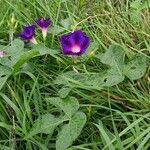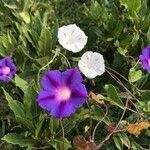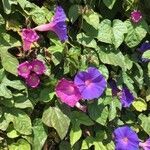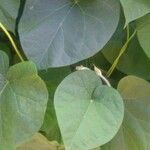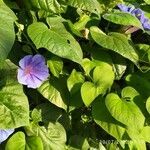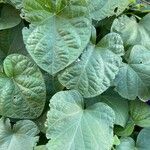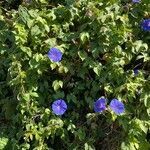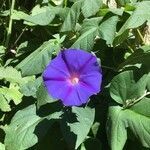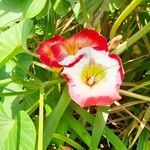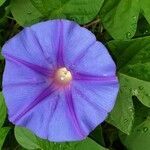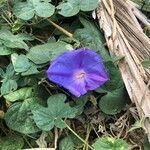Fibrous-rooted annual. Stems twining, with retrorse hairs, tawny hirsute when young, otherwise smooth. Petioles long, sometimes > lamina, with retrorse hairs. Lamina 5-16-(18) × 4.5-11-(13) cm, broad-ovate, entire or nearly so, occasionally with lobes near base, with appressed hairs at least on veins; base cordate with rounded sinus; apex acute or abruptly acuminate. Cymes axillary, few-flowered; peduncles 5-10 cm long with dense retrorse hairs; pedicels variable but < peduncles, with dense retrorse hairs. Bracts narrow-linear, < pedicels. Calyx 1.3-1.6 cm long; sepals oblong-lanceolate, acute, the lower part densely covered with stiff and bulbous-based hairs. Corolla c. 5 cm long and 5-6 cm diam. across limb, funnelform; basal part of tube pink; remainder of corolla violet-purple except for dark reddish purple mid-petaline bands. Stamens included, the longest c. 2.5 cm long; filaments hairy towards base. Style > stamens. Capsule globular, glabrous; beak inconspicuous. Seeds < 7 mm long, glabrous, dark.
Herbs annual, twining; axial parts short pubescent and long retrorse hirsute. Stems 2-3 m. Petiole 2-12 cm; leaf blade circular-ovate or broadly ovate, 4-18 X 3.5-16.5 cm, ± strigose, base cordate, margin entire or ± 3-lobed, apex acute or ± abruptly acuminate. Inflorescences 1-5-flowered; pedun-cle 4-12 cm; bracts linear, 6-7 mm, spreading hirsute. Pedicel recurved before and after anthesis, 1.2-1.5 cm. Sepals subequal, 1.1-1.6 cm, spreading hirsute abaxially in basal 1/2; outer 3 oblong, apex acuminate; inner 2 linear-lanceolate. Corolla red, reddish purple, or blue-purple, with a fading to white center, funnelform, 4-6 cm, glabrous. Stamens included, unequal; filaments pubescent basally. Pistil included; ovary glabrous, 3-loculed. Stigma 3-lobed. Capsule subglobose, 9-10 mm in diam., 3-valved. Seeds black or straw colored, ovoid-trigonous, glabrous or hilum sparsely pilose. 2n = 30, 32.
Herbaceous annual. Stems trailing or twining, glabrous to retrorsely hairy. Leaves broadly ovate to suborbicular, 40-150 x 25-120 mm, entire or very rarely 3-lobed, apex acuminate, base cordate with rounded auricles, hairy to glabrous on both surfaces; petiole retrorsely hairy, 20-150 mm long. Inflorescence axillary, cymosely 1-to few-flowered; peduncle hairy, 30-180 mm long; bracteoles linear, up to 7 mm long; pedicels hairy, up to 20 mm long in fruit. Sepals unequal, 10-15 mm long, up to 20 mm in fruit, acute, with bristly patent hairs in basal portion, outer ones oblong, inner ones ± linear. Corolla funnel-shaped, glabrous, 50-60 mm long, ±60 mm wide, white, pink, magenta, reddish purple or purplish blue with paler tube and distinct midpetaline areas. Capsule globose, ±10 mm wide, glabrous. Seeds subglabrous, black.
Annual herb; glabrous or retrorsely hairy. Stems trailing or twining. Leaves broadly ovate to suborbicular, 40-150 x 25-120 mm, base of blade cordate with rounded auricles, apex acuminate, margin entire, hairy to glabrous on both surfaces; petioles 20-150 mm long. Flowers: peduncle 1-few-flowered; calyx lobes unequal, outer ones oblong, inner ones ± linear, 10-15 mm long, apices acute, with bristly patent hairs on basal portion; corolla 50-60 mm long, ± 60 mm in diameter, white, pink, magenta, reddish purple or purplish blue with paler tube, distinct midpetaline bands; Nov.-May. Fruit a globose, glabrous capsule; seeds glabrescent.
Glabrous to retrorsely hairy, herbaceous annual. Stems trailing or twining. Leaves broadly ovate to suborbicular, 40-150 mm, entire, base cordate, apex acuminate; petioles 20-150 mm long. Inflorescence 1-few-flowered; peduncle 30-180 mm long; bracteoles linear, up to 7 mm long; pedicels up to 20 mm long in fruit. Sepals unequal, 10-20 mm long, bristly patent hairs basally, oblong to linear. Corolla funnel-shaped, glabrous, 50-60 mm long, white, pink to purple-blue with paler tube and distinct midpetaline areas. Flowering time Nov.-May. Fruit a globose, glabrous capsule, 10 mm wide. Seeds glabrous, black.
Annual herb.. Stems glabrous or bristly-pubescent, trailing or twining.. Leaf-blade ovate, entire or 3-lobed, 7.5 cm. long and wide, acuminate at the apex, cordate at the base, glabrous or pubescent; petiole 7.5–9 cm. long.. Flowers solitary or in few-flowered cymes; peduncle up to 12 cm. long; pedicels 1.3–2.5 cm. long.. Sepals lanceolate, 1.3–1.6 cm. long, 1.5–4.5 mm. wide, usually not conspicuously attenuated at the apex, bristly below, finely pubescent all over.. Corolla white, pink or magenta; tube white below, 4.5 cm. long.. Capsule 1.1 cm. in diameter, glabrous, 3-locular.
Vines; stems slender and herbaceous, annual, pilose or hirsute with spreading trichomes. Leaves broadly ovate to cordate, 2-10 cm long, entire or trilobate, pubescent on both surfaces. Flowers in 1-5-flowered cymose clusters on pedun-cles usually longer than the petioles; sepals oblong-lanceolate, 8-16 mm long, apically abruptly acute, hirsute on the basal portion; corolla blue, purple, pink, or with stripes of these colors on a white background, throat white, 3-5 cm long. Fruits capsular, depressed-globose, 10 mm in diameter; seeds black, pyriform, glabrous.
Annual; stems pubescent, to 5 m; lvs round-cordate to ovate-cordate, entire (very rarely 3-lobed), abruptly short-acuminate or merely apiculate, glabrous to sparsely hairy; peduncles nearly or quite equaling the subtending petioles, 1–5-fld; sep lance-ovate to oblong, acute or acuminate, hirsute toward the base, commonly 10–15 mm; cor blue, purple, white, or variegated, 4–6 cm; ovary 3-locular; stigma 3-lobed; 2n=30. Native of trop. Amer., escaped from cult. and now a weed in fields, roadsides, and waste places in much of our range. July–Sept. (Pharbitis p.)
Flowers solitary or in few-flowered cymes; peduncle up to 15 cm. long; pedicels shortly hairy or with a few bristles, 8–15 mm. long; Sepals unequal, 10–15 mm. long, accrescent up to 20 mm. long in fruit; outer ones oblong, acute with bristly patent hairs in basal portion; inner ones with narrow scarious margins, linear-oblong to linear, acute with a few bristles near the base.
Trailing or twining annual herb. Leaves ovate to sub-circular in outline, entire or 3-lobed, base cordate with broadly rounded auricles, apex acuminate. Outer sepals oblong, acute with bristly patent hairs in basal portion; inner ones linear-oblong to linear, acute, 10-15 mm long. Corolla 45-60 mm long. Flowers white, pink or magenta, tube white below.
Leaf lamina ovate to subcircular in outline, entire or 3-lobed, 4–16 × 3–15 cm., the base cordate with broadly rounded auricles, the apex acuminate, glabrous or pubescent; petiole 6·5–15 cm. long, retrorsely hirsute.
A twining herb. It can lie along the ground or climb to 2.5 m high. The leaves are oval and can have 3 lobes. They are 4-16 cm long by 3-15 cm wide. The flowers are white pink or red. They are funnel shaped.
Thinly hairy, vigorous, annual climber to 5 m. Leaves cordate. Flowers purple, sepals thickly hairy beneath, acute.
Stems trailing or twining, glabrous or with short hairs mixed with longer retrorse bristles.
Corolla funnel-shaped, white, pink or magenta 4·5–6 cm. long; tube white below.
Seeds black, glabrous or very shortly pubescent.
Ornamental herbaceous annual.
Capsule globose, glabrous.
